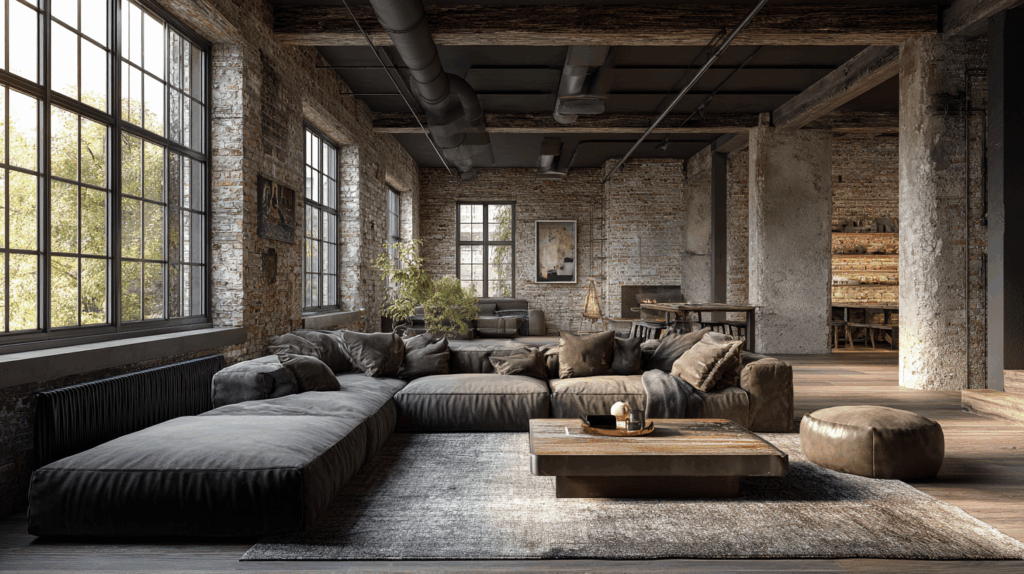When I first stepped into my loft, the exposed beams and brick walls gave me goosebumps. It had so much potential, but honestly, I had no clue how to make it feel like home.
It was too bare, too cold, more warehouse than warm. I didn’t want to lose the raw character, but I needed comfort too.
That’s how I found myself trying out industrial design and slowly figuring out what worked.
This blog is for anyone in that same spot. No matter if you’re working with an open loft or just want to add a few gritty details to your space, I’m sharing ideas that blend character with comfort.
From big furniture choices to small finishing touches, everything here is simple, doable, and personal.
You’ll leave with real ways to bring the look home.
What Is Industrial Interior Design?
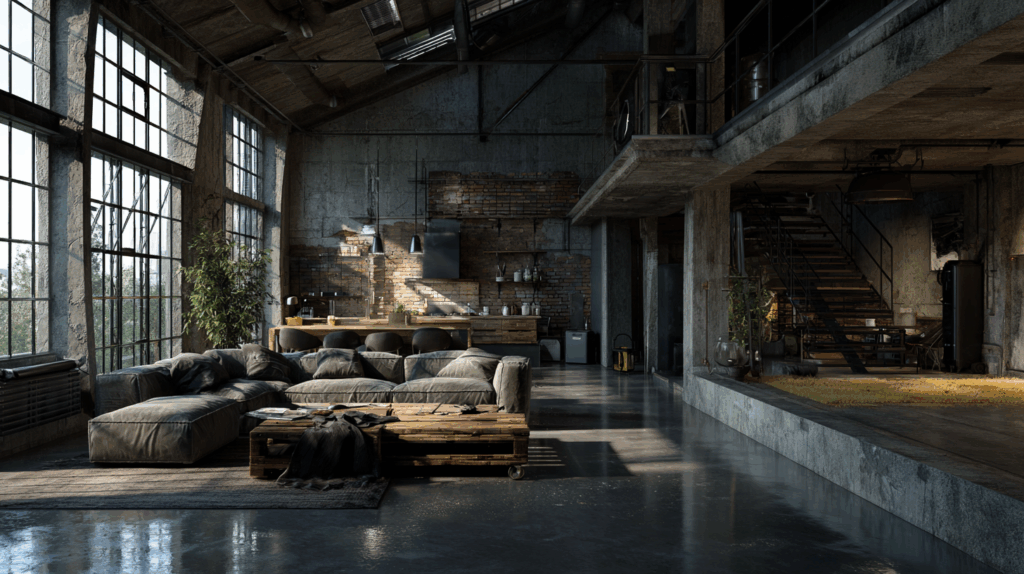
Industrial interior design comes from old factories and warehouses. Instead of hiding the structure, it celebrates it. You’ll see raw textures, exposed elements, and a practical feel.
The walls are often brick or bare concrete. You’ll find finishes made of metal, wood, or stone. The color palette stays neutral, think gray, black, tan, and earthy tones.
Spaces are usually large and open, letting in plenty of natural light. There’s a sense of airiness and function.
Modern industrial design keeps that same base, but adds softer details. You might see cleaner lines, cozy fabrics, and a bit more warmth.
You don’t have to stick with just one style. Classic and modern industrial can mix well, depending on what fits your space and taste.
Creative Industrial Interior Design Ideas that You Can Consider
Industrial style is all about contrast, creativity, and character. You don’t need to follow strict rules, just mix raw, unfinished elements with warm, practical touches. Try these creative ideas to bring the look to life in your own space.
1. Mix Rough and Soft Textures
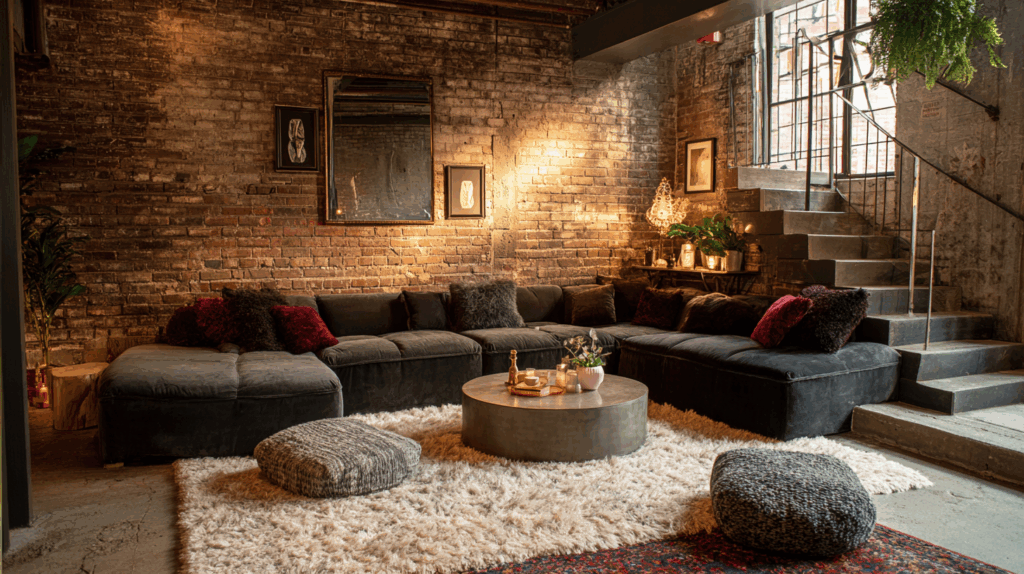
Pairing rough surfaces with soft materials keeps your space cozy yet bold. Think exposed brick with a fluffy rug, a concrete floor softened by linen curtains, or a metal bed frame topped with velvet cushions.
This contrast creates balance and prevents the space from feeling too cold or harsh. Rough textures ground the space, while soft ones add warmth and comfort.
You don’t have to overdo either, just use both in small touches to build that lived-in, layered industrial charm.
2. Use Salvaged or Secondhand Furniture
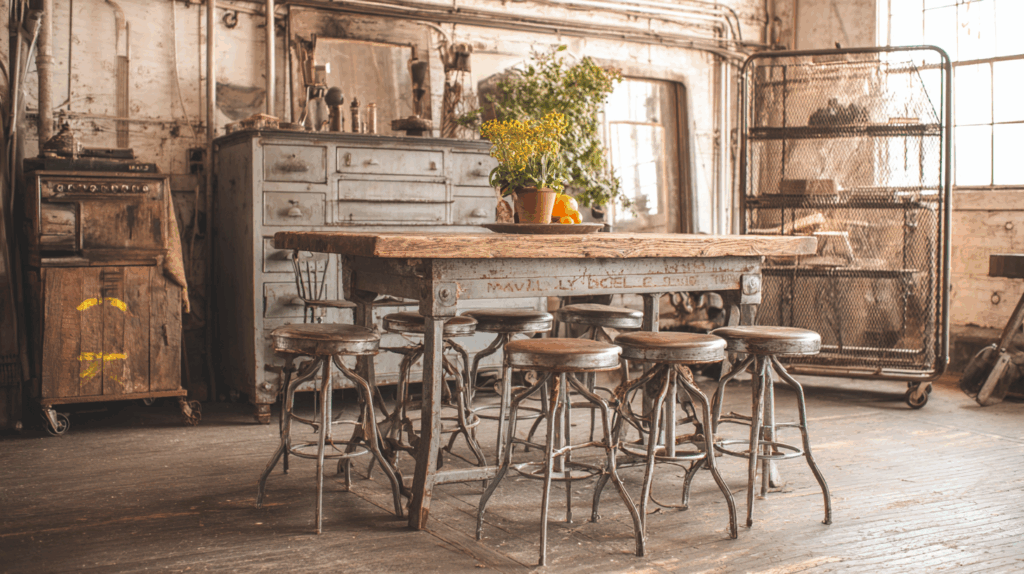
Salvaged pieces bring authentic industrial character to your home. Old lockers, wire carts, metal desks, or distressed stools carry that worn-in vibe that fits the style perfectly.
Don’t worry about matching sets, mismatched finishes, and visible wear, as they add to the appeal. Look for bargains at flea markets or secondhand stores.
These unique pieces not only save money but also add history and personality to your space. It’s one of the easiest ways to make your industrial design feel genuine and not mass-produced.
3. Hang Edison Bulb Pendant Lights
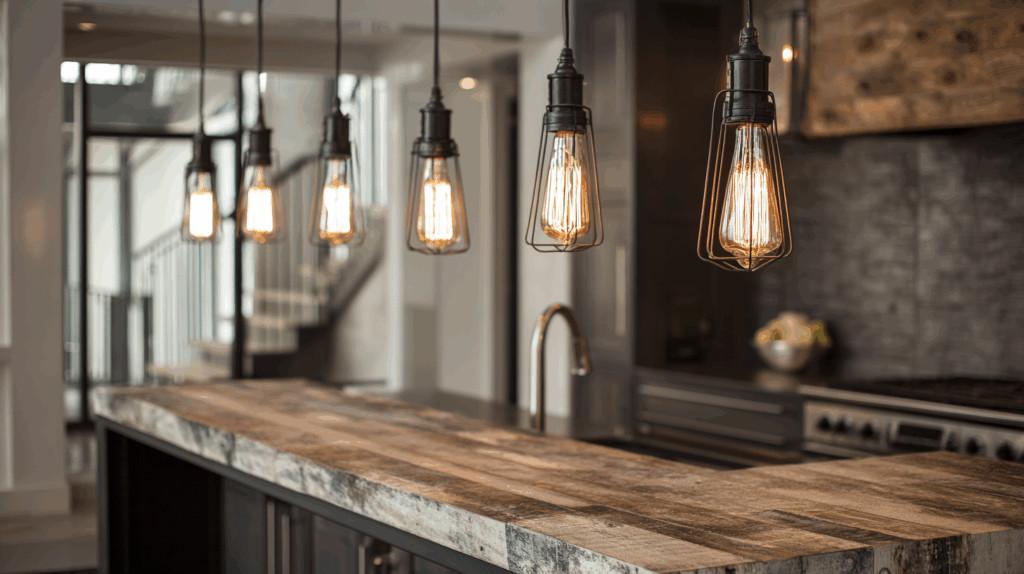
Exposed Edison bulb pendant lights are a staple in industrial design. Their warm, amber glow and visible filaments add charm and old-school factory vibes.
Hang them over a dining table, kitchen island, or reading nook for soft but stylish lighting. Choose fixtures with black, brass, or cage-style finishes to enhance the raw look.
Even a simple cord-and-bulb combo works beautifully. These lights are affordable, easy to install, and immediately add that warehouse-inspired atmosphere without needing a full renovation.
4. Add a Brick Accent Wall
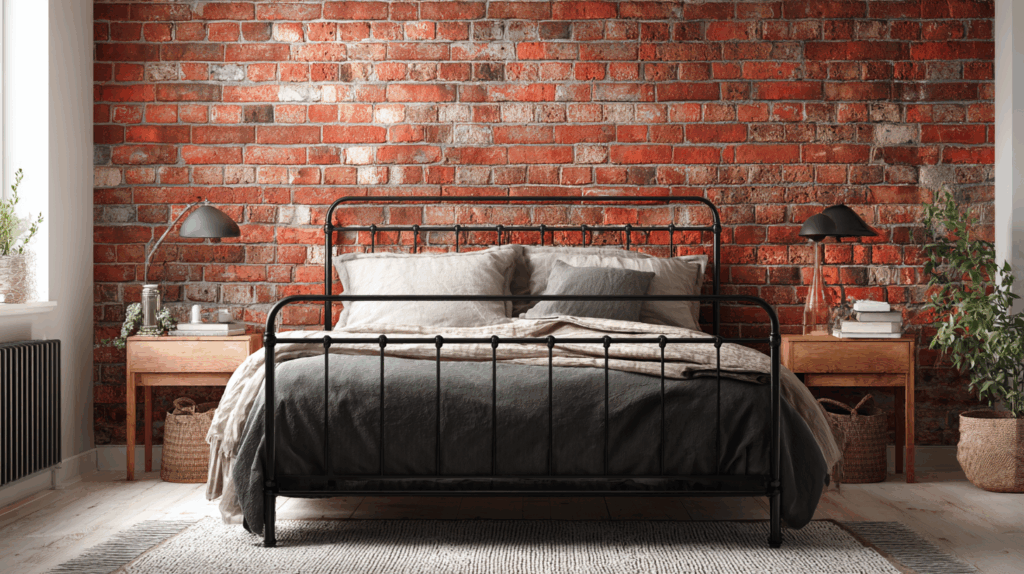
A brick accent wall adds instant industrial texture. If your home doesn’t have exposed brick, don’t worry, as faux brick panels, wallpaper, or peel-and-stick options can give you the same look.
Use it in a living room, bedroom, or kitchen backsplash to bring in that raw, unfinished vibe. Keep the surrounding decor simple to let the brick stand out. It creates a focal point that feels both rugged and warm.
This single change can transform a plain space into something with character.
5. Layer Modern Art on Raw Walls
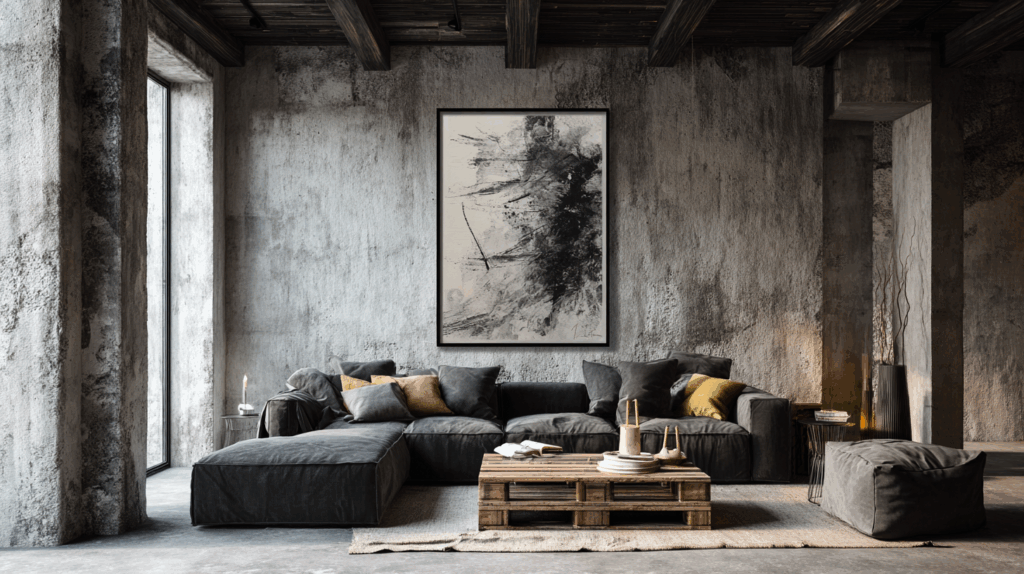
Modern or abstract art layered over raw walls adds a creative twist to industrial design. Think oversized black-and-white prints, edgy line art, or bold graphic pieces hung on brick, concrete, or plaster.
The contrast between sleek artwork and rough surfaces keeps things interesting. You don’t need a full gallery wall, as just one or two pieces can make a big impact.
This approach blends modern and industrial styles, giving your space a curated, artistic feel while still honoring the raw materials underneath.
6. Install Black-Framed Windows or Partitions
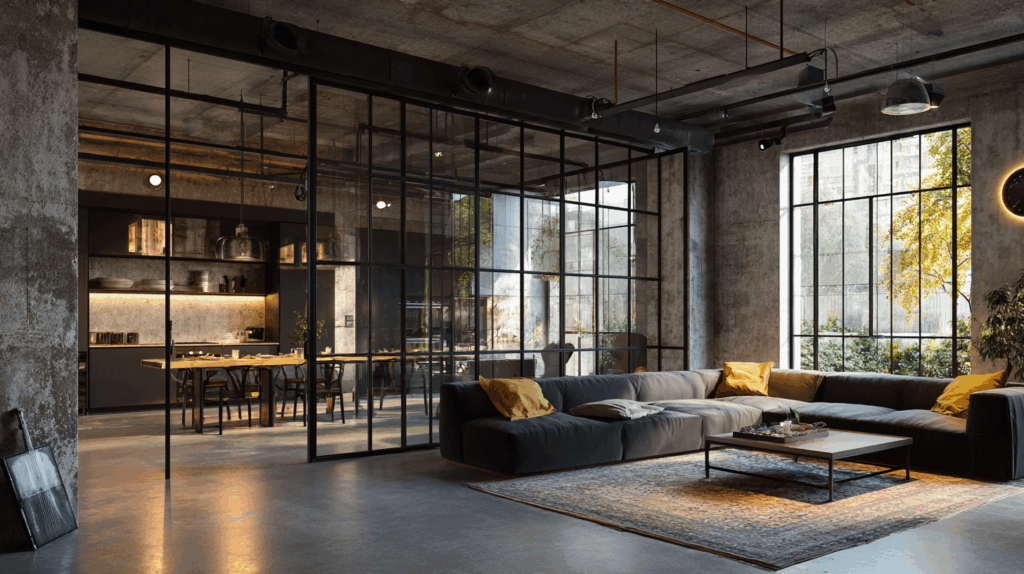
Black metal frames add sharp definition to open spaces.
If you can’t renovate, try using decals or black tape on existing glass to fake the look. You can also install framed glass partitions to divide rooms while keeping that open, airy feeling.
These grid-style frames echo old factory windows and work especially well in lofts or modern apartments. They’re a stylish way to add structure without blocking light.
Even mirror frames, shower doors, or cabinet inserts can feature this industrial detail.
7. Use Concrete Planters
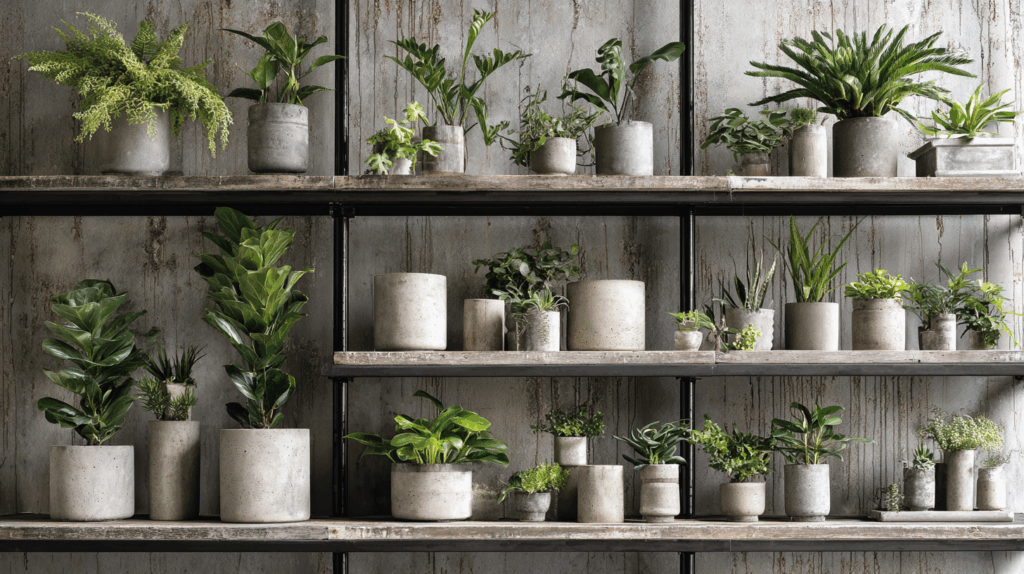
Concrete planters add clean, minimal texture that fits the industrial look without being too loud.
They come in all sizes, from small desktop pots to large floor planters, and are perfect for showcasing greenery. The smooth gray finish pairs well with leafy plants like snake plants, ferns, or succulents.
Use them indoors on shelves, counters, or the floor. It’s a subtle but effective industrial touch.
8. Bring in Leather or Canvas
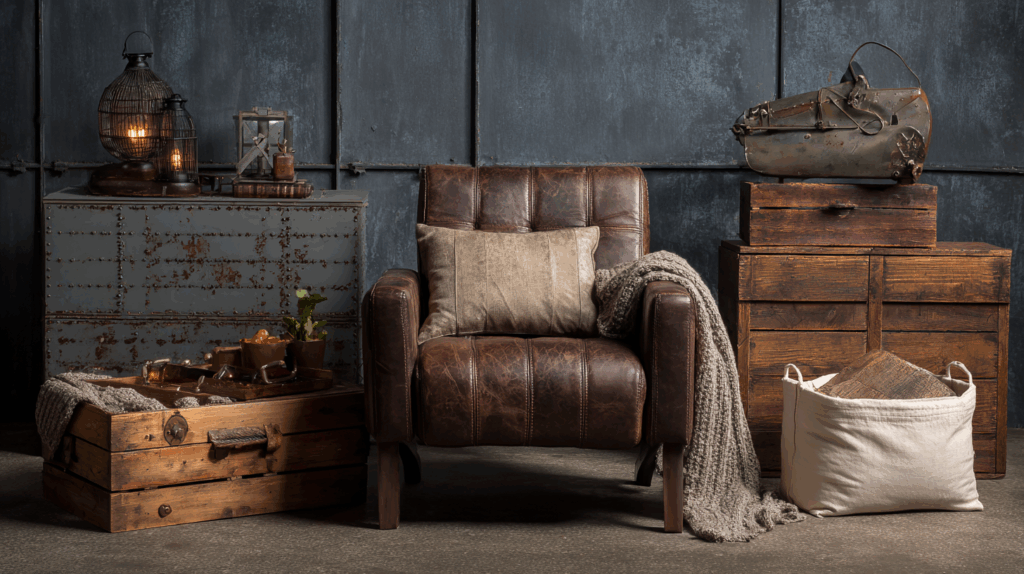
Leather and canvas offer both durability and style in an industrial space. A distressed leather chair or a simple canvas laundry bin adds texture without fuss.
These materials age well, developing character over time. Look for dark brown or tan leather for warmth, or opt for neutral-toned canvas in storage pieces like bins, cushions, or wall organizers.
The muted tones fit perfectly with the industrial color palette. These materials are practical and stylish, blending comfort with rugged charm.
9. Hang a Vintage Wall Clock
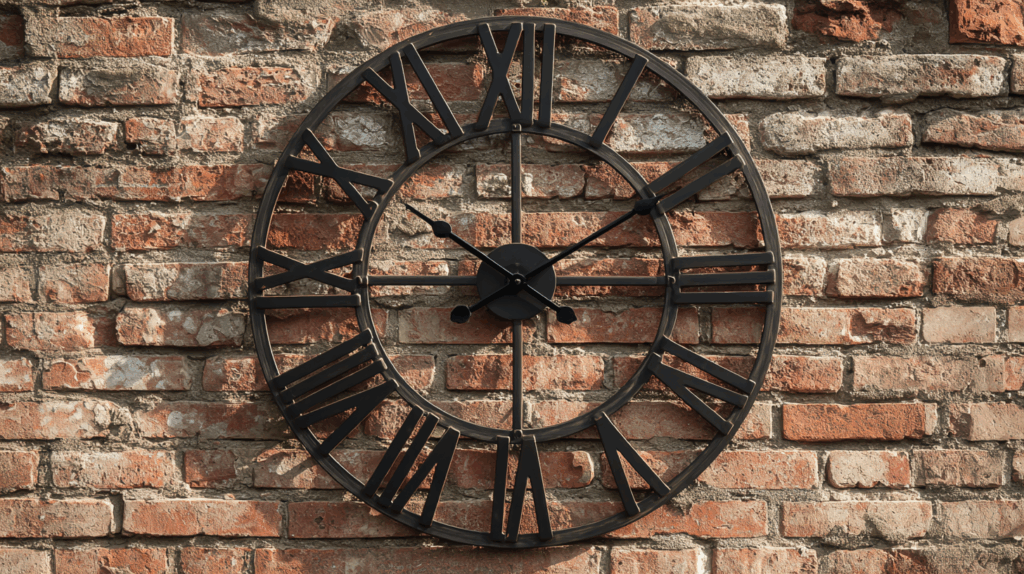
A large, vintage-style wall clock makes a bold statement in any industrial room. Choose a metal or wood frame with bold numerals and aged finishes.
Oversized clocks work especially well in living rooms or kitchens as functional art pieces. They echo the factory style while serving a real purpose.
You can even find battery-operated options with old-school charm. Hang one on a brick wall or over a reclaimed wood console to anchor your decor and reinforce the industrial theme.
10. Use Open Pipe Shelving
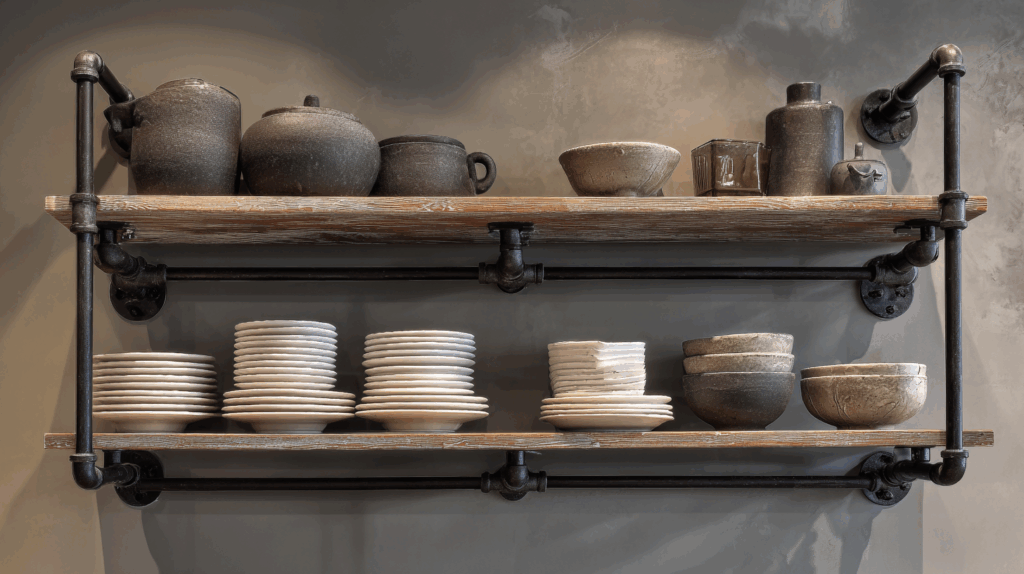
Open pipe shelving combines wood planks with metal plumbing pipes for a raw, functional look. It’s easy to build or buy and works in kitchens, bathrooms, or home offices.
These shelves offer open storage while doubling as industrial-style decor. Use them to display dishes, books, or plants. The mix of metal and wood keeps things grounded and uncluttered.
Pipe shelves are especially helpful in small spaces, giving vertical storage without feeling bulky. Plus, they’re strong, simple, and full of character.
11. Add Metal Bar Stools
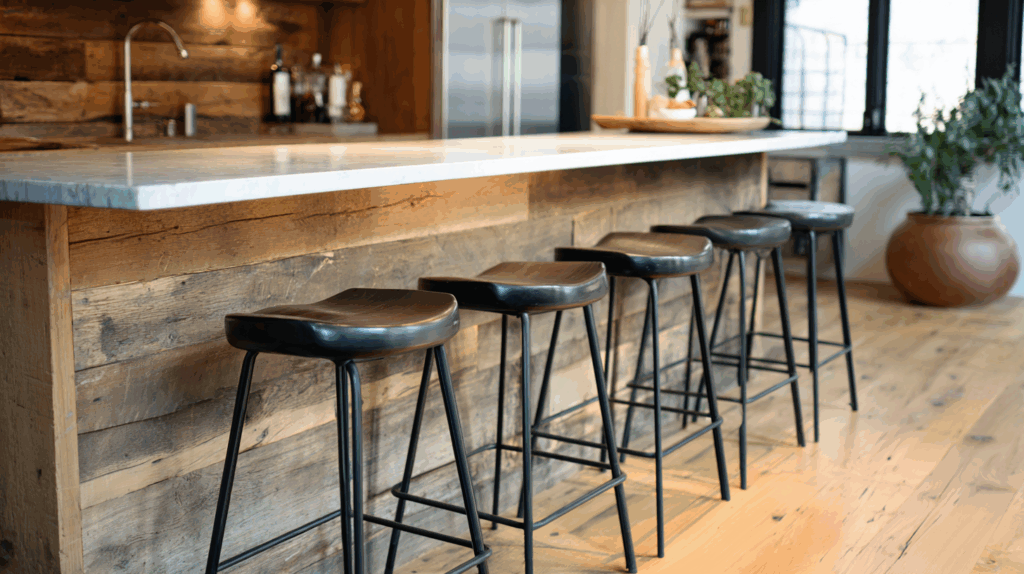
Metal bar stools are a must-have if you have a kitchen island or high-top table. Look for ones with a matte black, gunmetal, or brushed steel finish. Some come with wooden seats for added warmth.
These stools are durable, easy to clean, and instantly elevate your space with an industrial edge. Choose backless styles for a minimal look or opt for vintage-inspired designs with curved backs and rivets.
Either way, they bring utility and charm while reinforcing the factory-style vibe.
12. Place a Rolling Cart in the Kitchen
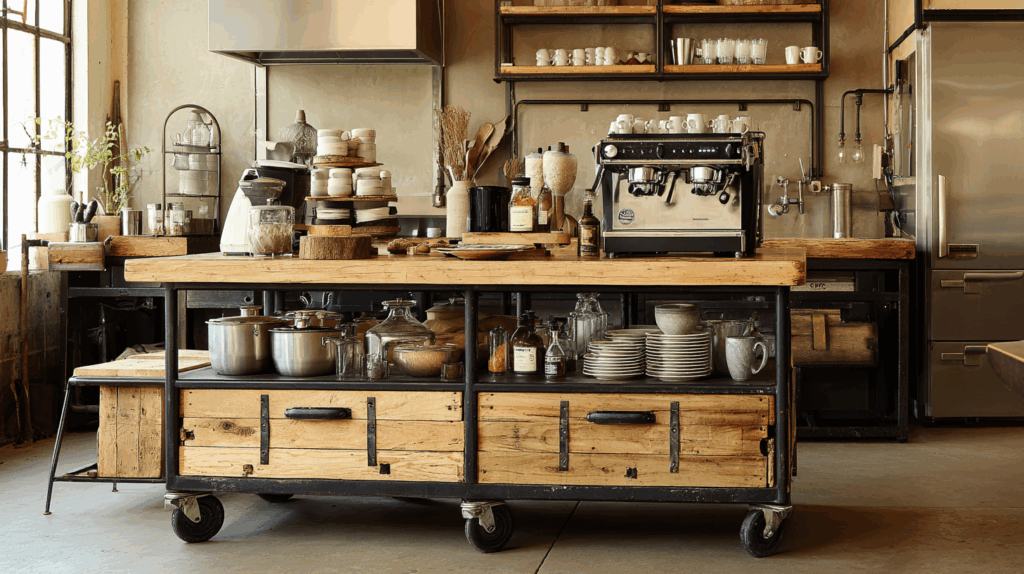
A rolling cart is one of the most useful pieces in an industrial kitchen.
You can use it as a coffee station, bar cart, or extra prep surface, as it adds both function and style. Look for one made of wood and metal with casters for mobility.
The open design makes it easy to store and access dishes, drinks, or tools. Plus, it adds that workroom feels that’s core to industrial interiors. You can move it wherever needed, making it super versatile.
13. Try a Pipe-Style Clothing Rack
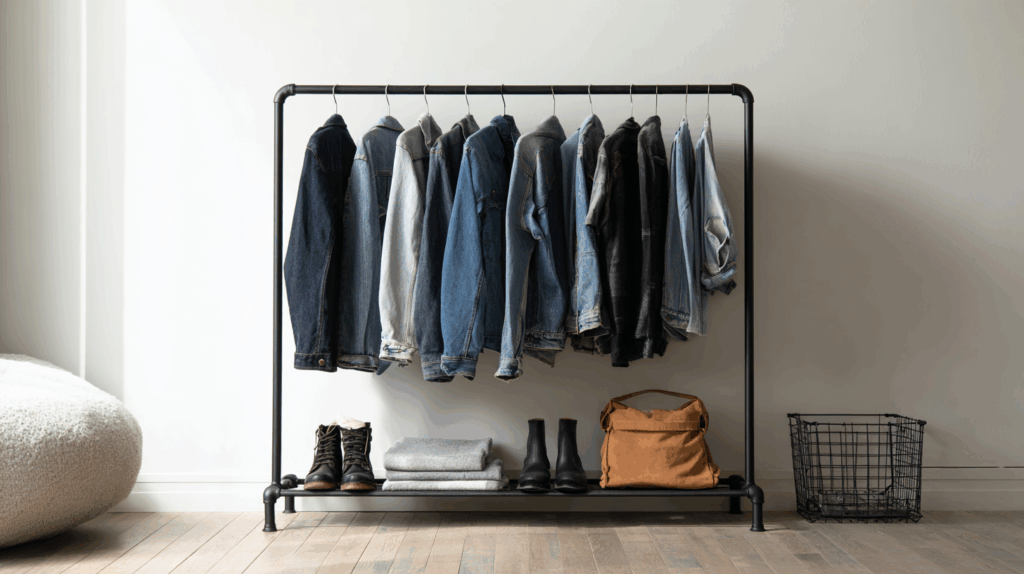
A pipe-style clothing rack adds industrial flair to bedrooms, closets, or entryways. Made from black metal pipes, it mimics the look of exposed plumbing while offering useful hanging space.
Use it to display your favorite jackets, jeans, or accessories. It’s perfect for small spaces or open-concept bedrooms where you want to keep things light and airy. You can DIY it or buy pre-made versions.
It brings both style and storage, blending form and function in an industrial way.
14. Paint a Wall Matte Black

A matte black accent wall can completely shift the feel of a room. It creates a dramatic backdrop for art, furniture, or lighting while keeping things grounded.
In an industrial setting, black pairs beautifully with raw wood, metal, and concrete. The flat finish adds depth without the glossiness of traditional paint.
Use it in a bedroom behind the headboard or in a living room to highlight open shelving. It’s bold but not overbearing and perfect for adding contrast and mood.
15. Use Metal Baskets for Storage

Metal baskets are a simple, stylish way to keep things organized. Use them in the bathroom for towels, in the pantry for snacks, or under the coffee table for books and magazines.
Wire or mesh designs let you see what’s inside and keep things feeling open. Choose black, bronze, or silver finishes to match your decor.
These baskets are both decorative and practical, and they hold up well in high-use areas. They add texture and tie in effortlessly with the industrial look.
16. Add a Steel or Iron-Framed Mirror
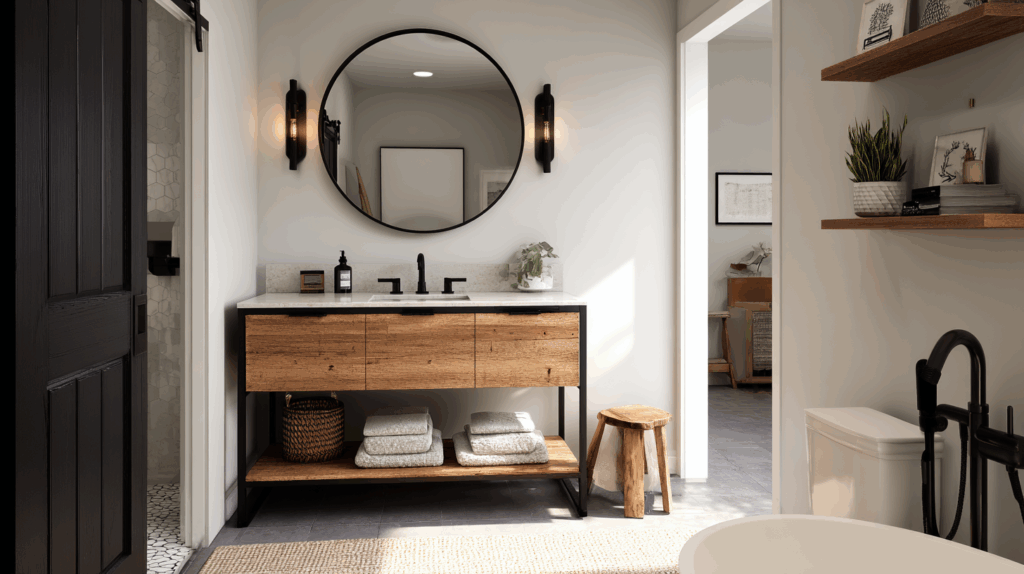
A steel or iron-framed mirror brings clean lines and subtle industrial strength to a room. It’s perfect for bathrooms, hallways, or entryways, where it adds light and function without losing the style.
These mirrors often come in black, gray, or rust finishes and can feel vintage or modern depending on the shape. Choose round for softness or square for a sharper edge.
Even a basic mirror gets an upgrade with a raw, metallic frame, as it’s an easy swap with a big visual impact.
17. Use Pulley Lights or Wall-Mounted Lamps
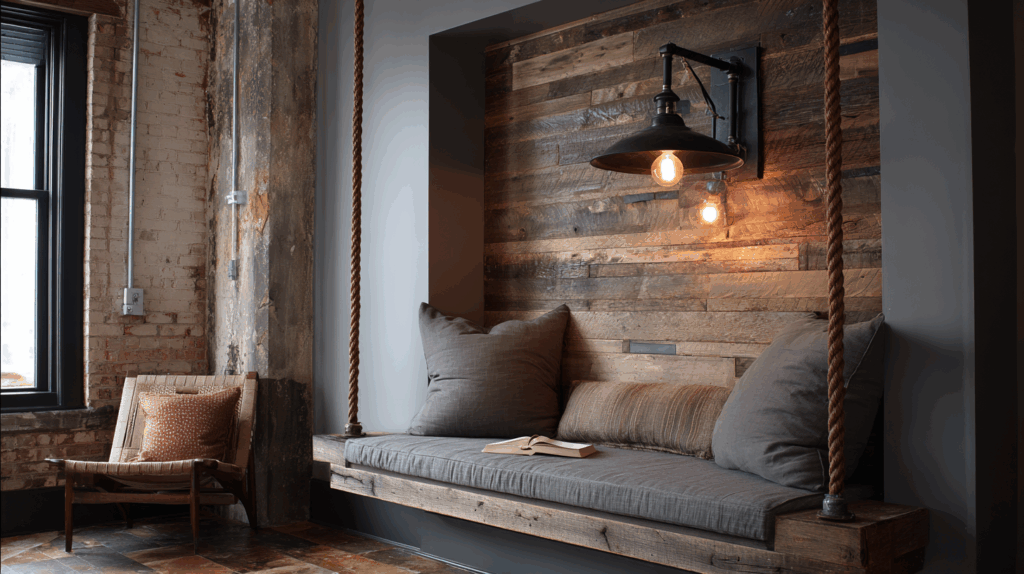
Pulley lights and swing-arm lamps have a mechanical, workshop-inspired vibe that suits industrial spaces perfectly. The moving parts give a sense of function and history, like something repurposed from an old factory.
Mount them over a reading nook, kitchen counter, or beside the bed for task lighting that doubles as decor. You can find real vintage fixtures or modern replicas, both offering that same practical charm.
They’re an ideal way to bring motion and interest into your lighting design.
18. Try a Reclaimed Wood Headboard
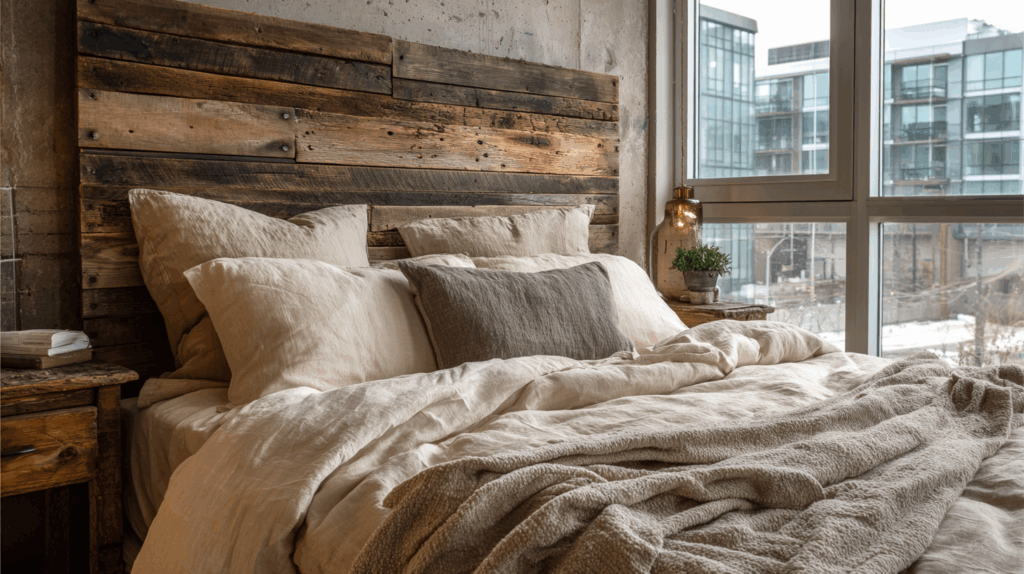
Reclaimed wood has texture, color variation, and visible grain that makes a strong statement in any bedroom.
Use planks from pallets, old barns, or salvage yards to create a DIY headboard that adds warmth and authenticity.
The rough surface pairs well with smooth bedding and clean walls, giving your space a cozy but rugged feel. This kind of wood tells a story and offers charm you can’t buy new. No need to stain it, just seal and let it shine naturally.
19. Show Off Concrete or Stone Countertops
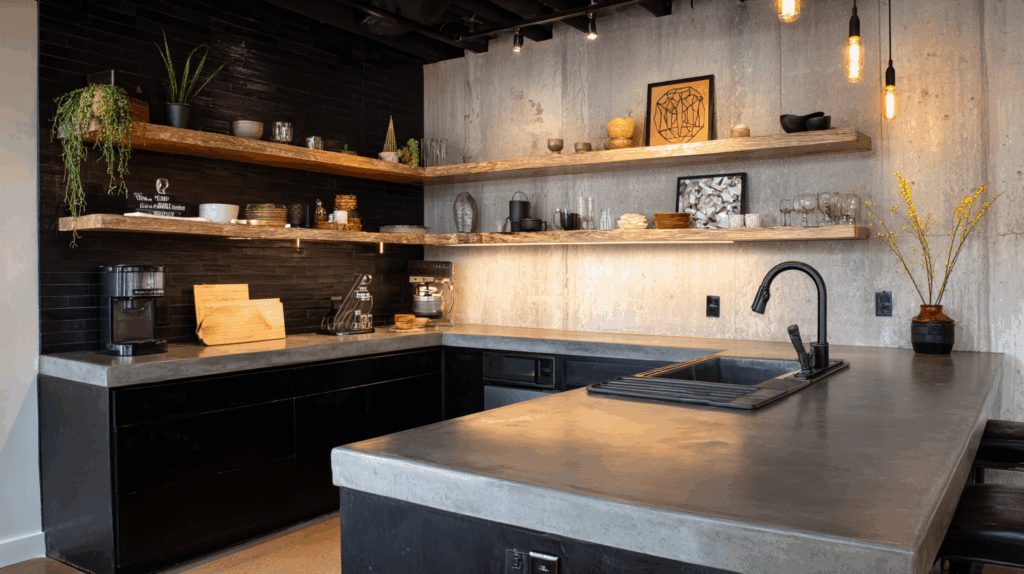
Concrete and stone countertops are sleek, solid, and beautifully industrial. Choosing polished concrete, soapstone, or honed granite adds weight and texture to kitchens or bathrooms.
Keep them sealed to avoid stains, but don’t hide the imperfections, as those marks and flecks add charm.
Their matte finish pairs well with metal hardware and open shelving. It’s a bold, functional choice that works well with both minimal and rustic details. You don’t need flashy colors. Let the material speak for itself.
20. Use Black Hardware on Cabinets
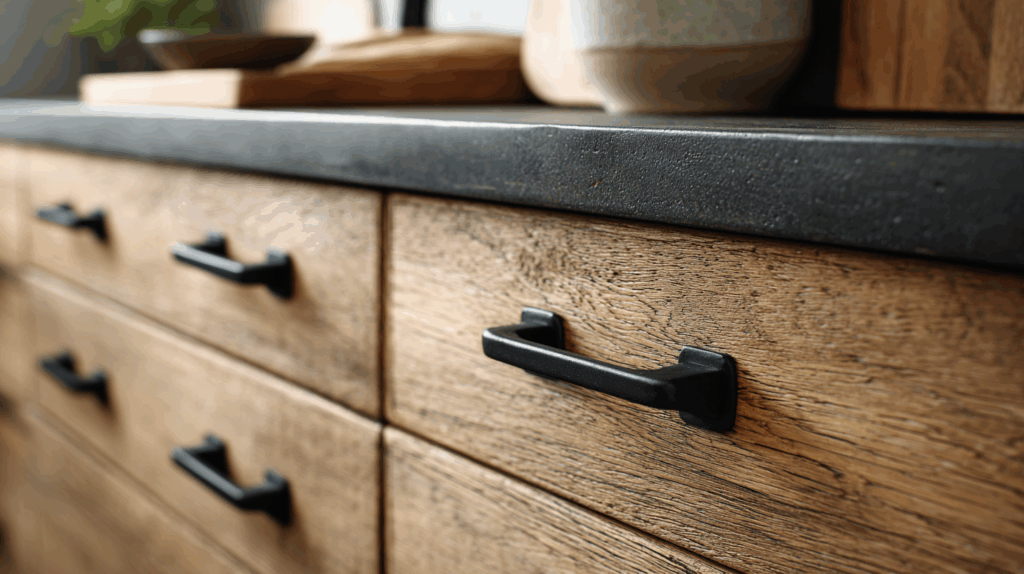
Swapping out cabinet handles for black ones is a fast and affordable way to give your kitchen or bathroom an industrial touch. Matte black or iron pulls look great against natural wood, white paint, or even navy cabinetry.
They help tie together other industrial elements like lighting, shelves, or faucets. This small change adds contrast and definition without a full remodel.
Choose simple shapes or vintage styles depending on your space. It’s a detail that often gets overlooked but makes a big difference.
21. Display Tools or Gears as Decor
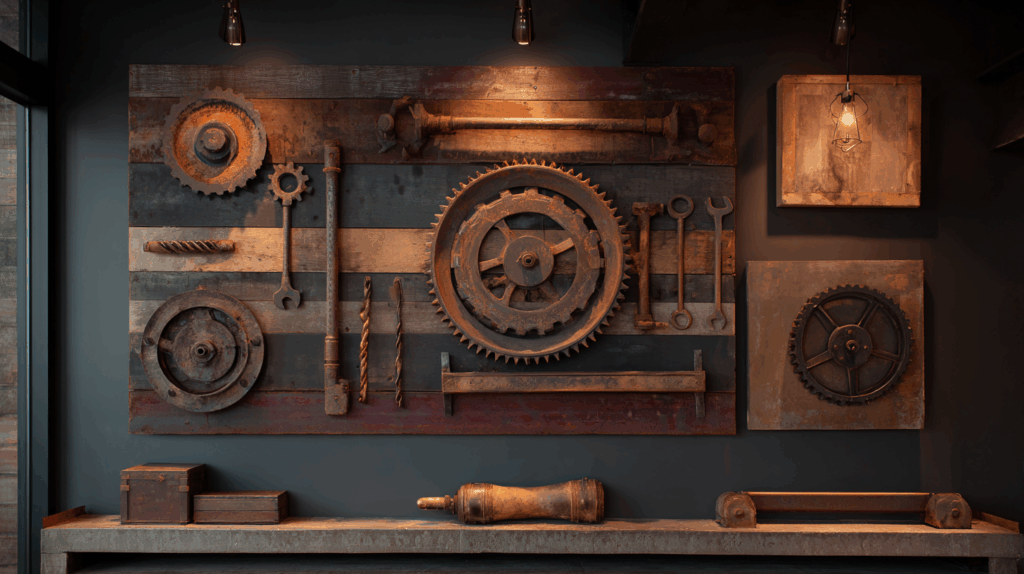
Old tools, gears, and mechanical parts make excellent wall or shelf decor in industrial spaces. Hang vintage wrenches, large metal gears, or even rusted cogs in shadow boxes or as part of a gallery wall.
These items add history and interest, turning something functional into art. Look at salvage yards, antique stores, or even your garage for unique pieces.
They work especially well in workshops, offices, or mudrooms. It’s all about finding beauty in the mechanical and imperfect.
22. Hang Industrial-Inspired Art or Photography
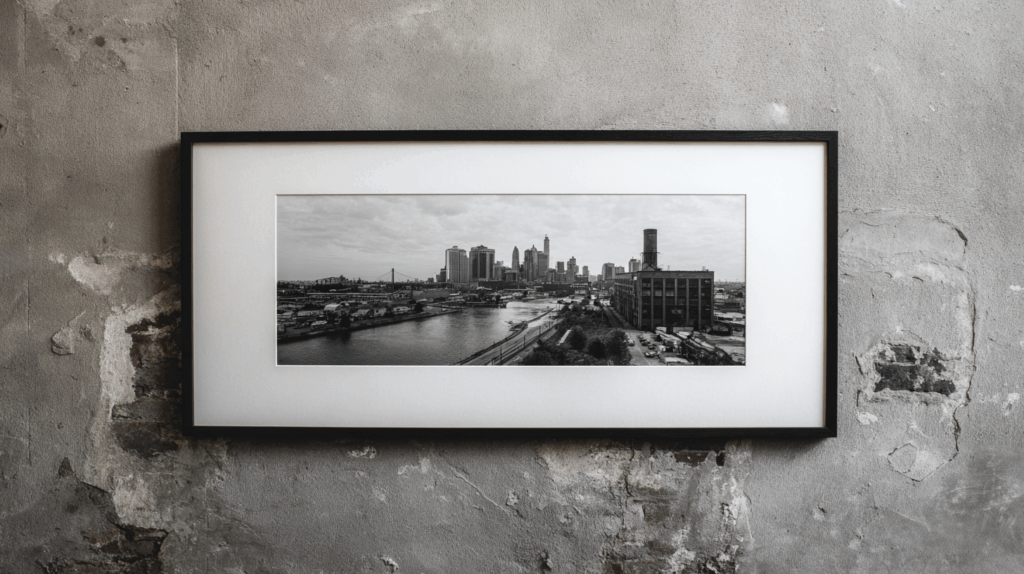
Bring personality into your industrial space with framed prints that echo the style. Look for black-and-white photos of factories, city skylines, fire escapes, or structural details like bridges.
Even architectural sketches or blueprints can work beautifully. The key is to stick to monochrome or neutral tones so the art complements rather than clashes. Use metal frames or clipboards for a rugged finish.
This kind of artwork ties in the industrial vibe without being too literal, as it adds mood, not clutter.
23. Use Wire Chairs or Stools

Wire seating is practical, sculptural, and lightweight, and ideal for small industrial spaces.
These chairs work in dining rooms, offices, or even as accent pieces. Look for black, metal, or chrome finishes, and pair them with a leather seat pad for extra comfort.
Their open design keeps things from feeling bulky and adds a touch of vintage utility.
They’re easy to move, easy to clean, and stylish without trying too hard. Wire designs bring texture and interest without taking up visual space.
24. Try an Exposed-Bulb Chandelier
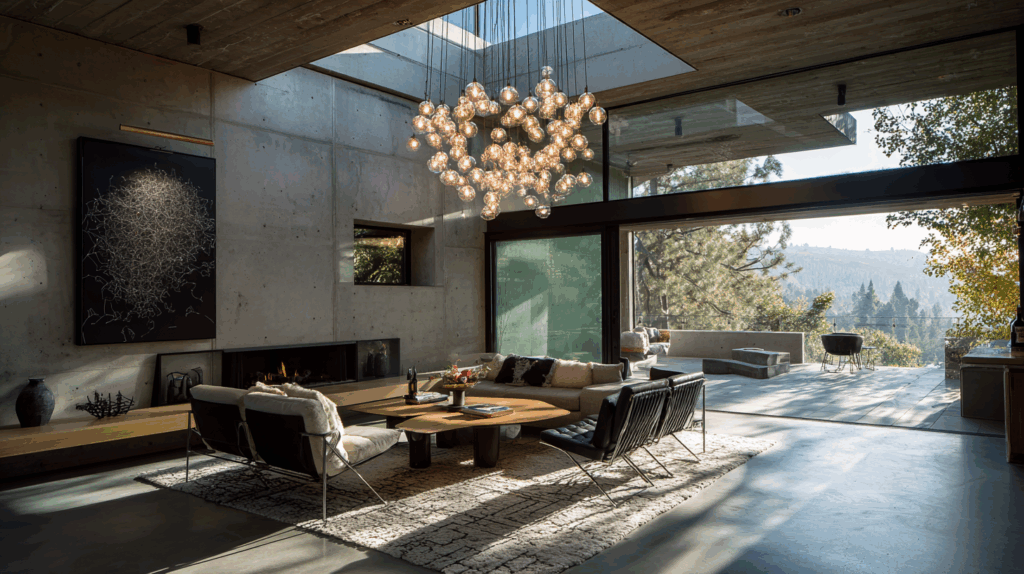
An exposed-bulb chandelier can be a striking centerpiece in a dining room or living space. Choose one with visible wiring, mixed metals, or pipe-style arms for that true industrial look.
It gives off plenty of warm light while acting as sculptural art. These fixtures don’t need shades or crystals, as they shine because of their bare-bones style.
Minimalist or dramatic, these pieces add height, energy, and character to your space. Install one above a table or seating area to naturally draw the eye upward.
25. Use Cement Tiles or Concrete-Look Flooring

You don’t have to pour a slab to get that industrial floor vibe. Cement-look tiles, peel-and-stick vinyl, or laminate options now mimic raw concrete beautifully.
Use them in entryways, bathrooms, or kitchens for durable, low-maintenance surfaces that still feel rugged and modern. The cool gray tone pairs well with almost any furniture.
Matte finishes are best to avoid glare and keep the vibe grounded. It’s an easy update that adds style without a full remodel or high cost.
Industrial design blends old and new, raw and polished. Use a few of these ideas or mix in more for texture and character. Choose what fits your space and let the details reflect your style.
How to Style an Industrial Home Room-by-Room
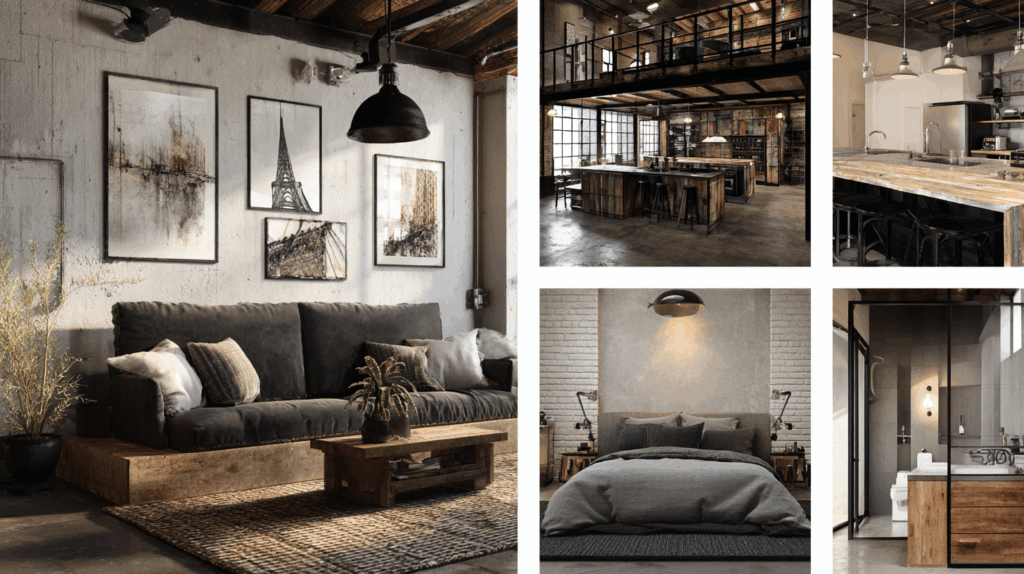
Industrial style works great when tailored to each room’s function. From raw materials to smart furniture choices, a few key pieces can transform any space into something practical and bold.
- Living Room: Keep the layout open and uncluttered. Use a leather couch for warmth, a metal coffee table for edge, and an exposed-bulb floor lamp to add height and glow.
- Kitchen: Stick with open shelves instead of upper cabinets. Add metal bar stools for seating and hang a pipe rack for pots. Wire baskets help keep things organized and visible.
- Bedroom: Go minimal but bold. A pipe-frame bed sets the tone, and an old trunk works as both storage and decor. Edison bulbs as bedside lights complete the vibe.
- Bathroom: Combine black fixtures with wood shelves for warmth. A concrete or stone sink makes a strong statement, and a metal-framed mirror ties the look together.
You don’t need to overhaul everything at once. Focus on small changes that add character, and let each room develop its own industrial charm at your own pace.
How to Combine Industrial with Other Styles
Industrial design doesn’t have to stand alone. Mixing in elements from other styles can help you create a space that feels more personal and layered.
For a Scandi-Industrial look, lighten things up with pale woods, clean lines, and neutral colors.
Boho Industrial brings in warmth with patterned rugs, lush plants, and handmade accents layered over brick and metal.
If you prefer something cleaner, Modern Industrial keeps the core materials but leans on simplicity, smooth surfaces, minimal decor, and soft textiles.
For a more rugged feel, Rustic Industrial uses deep wood tones, aged finishes, and vintage finds to create a cozy yet bold look.
Blending styles thoughtfully lets you express your taste while keeping the raw, practical vibe of industrial design intact.
Common Mistakes to Avoid
It’s fun to design an industrial space, but small mistakes can throw off the look. These are some of the things I’ve seen (and even done myself) that are worth watching out for:
- Too much gray or metal: If everything feels cold or flat, add wood, fabric, or warm tones to soften the look.
- Overdoing exposed bulbs: They’re stylish but can feel harsh. Mix in shaded lamps or wall sconces for comfort.
- Blending too many styles at once: A little mixing is great, but without a plan, things can start to clash fast.
- Choosing style over comfort: That metal chair may look amazing, but if you never sit on it, what’s the point?
Style isn’t just about how things look. It’s how things feel when you live in the space every day.
Quick Tips for a Balanced Industrial Look
If you’re aiming for something that feels pulled-together but still relaxed, these tips can help. You don’t need a big budget or a design degree, as just a few thoughtful moves can make all the difference.
- Start with neutrals: Stick to blacks, grays, browns, and natural wood as your foundation.
- Add texture with materials: Concrete, metal, reclaimed wood, and brick add instant depth.
- Mix old and new pieces: Pair vintage finds with modern furniture for a lived-in balance.
- Soften the hard edges: Use rugs, cushions, or curtains to warm things up and make it cozy.
- Keep decor intentional: Choose fewer items that serve a purpose or have a story.
- Make function your guide: Plan around how you use the space, not just how it looks.
Industrial design isn’t about perfection, as it’s about creating a space that feels real, useful, and a little rough around the edges in the best way.
Conclusion
I get it! You want your space to feel bold but not too hard, stylish but still comfortable. That’s exactly what industrial design can offer when it’s done right.
You don’t need a complete overhaul to make it work. You just need a few thoughtful choices that mix function with personality.
Now that you’ve seen what industrial style is all about and how easy it is to bring into any room, you’re ready to give your space a refresh.
Be it a vintage stool, updated lighting, or bold exposed textures, the aim remains unchanged: to create a space that feels authentic, unpolished, and uniquely yours.
This isn’t about following trends. It’s about finding your rhythm and letting your space speak with confidence.

